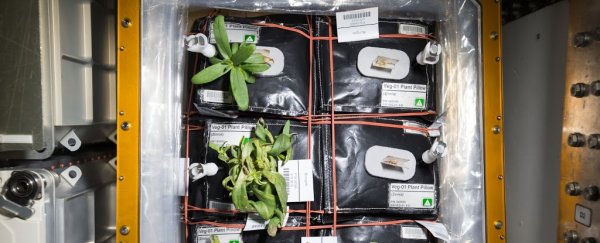If all goes to plan, in November this year the International Space Station (ISS) is about to get a bit spicier.
Researchers are hoping to send up Española chili pepper plants (Capsicum annuum), which could make peppers the very first fruit to be grown in space by US astronauts.
"We were also looking for varieties that don't grow too tall, and yet are very productive in the controlled environments that we would be using in space," NASA plant physiologist Ray Wheeler told Dylan Bida at the Rio Grande Sun.
"The astronauts have often expressed a desire for more spicy and flavourful foods, and so having a bit of hot flavour also seemed to be a good thing. Plus, many peppers are very high in vitamin C, which is important for space diets."
Although there are thousands of different types of chili peppers, Española peppers have been chosen in part because they grow at high altitudes, have short growing periods, and can be easily pollinated.
Astronauts and cosmonauts have been successfully growing plants in space stations since 1982, when the crew of the Soviet Salyut 7 spacecraft first grew the model plant Arabidopsis.
Russian cosmonauts have also been eating their own space produce since 2003, but it wasn't until 2015 that American astronauts got their first taste of space lettuce.
We've now grown plenty of different space vegetables on the ISS, including lettuce, Swiss chard, radishes, Chinese cabbage, and peas.
It's important to note here that peas are botanically part of a fruit, and Russians grew it for years in the Russian segment of the ISS. However, no US astronaut has so far grown a fruiting plant in space, meaning that later this year, the Española chili pepper could be the first.
Plants have quite a bit of trouble growing in microgravity, as their root systems are complex and typically use Earth's gravity to orientate themselves.
But astronauts have successfully coaxed plants into growing aboard the ISS by using special types of light, and supplementing other techniques for helping the plants figure out which way is "up" and "down".
Back in 2018, a new, nearly self-sufficient growth system called The Advanced Plant Habitat was sent up to the ISS, joining The Vegetable Production System (Veggie) to help the crew grow fresh food.
This is all important for NASA's ambitious plan to eventually send humans to Mars. We're looking at somewhere between six months and a year to make it to Mars, and once the space pioneers are on their way, we can't easily get them more fresh food from Earth.
That's not even mentioning their stay on the Red Planet, and then the trip home. Growing their own food is a pretty big priority.
"We can build all the rockets we want to go to Mars, but it won't work unless we have food to eat," Jacob Torres, a horticultural scientist at NASA, told Bida.
The researchers are working on having a variety of crops in space, particularly focusing on having a wide variety of nutrients and vitamins.
"We need to grow enough to supplement diet," Torres explained to CNN. "Just like here on Earth, we can't live on the same thing."
"Just imagine having a fresh pepper to bite into after months of eating cardboard," he added.
